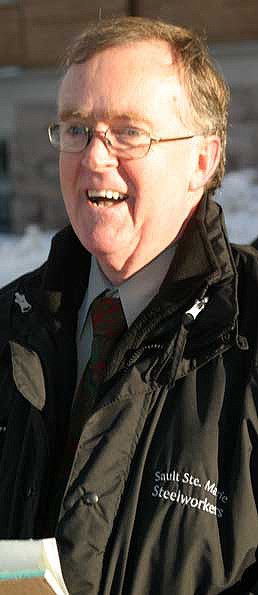NEWS RELEASE
TONY MARTIN, MP
************************* Peter MacKay commits Canada to bi-national investigation of St. Mary's River pollution
"This is what we asked for and what we will watch for..." - Tony Martin
OTTAWA – Foreign Affairs Minister Peter MacKay has written Sault MP Tony Martin agreeing to commit Canada to a bi-national investigation this summer and fall into the high bacteria levels and human sewage near Sugar Island in the St. Mary's River.
In a joint letter to Martin and U.S. Congressman Bart Stupak, Mackay says agencies on both sides are developing a sampling strategy to identify the pollution, its sources and remedial strategies.
The joint monitoring with river sampling is planned for this summer and fall.
"We are fully aware of the importance of this issue in terms of public health and we hope to find a solution in cooperation with the United States in a timely manner," MacKay wrote.
Martin said: "this is what (Congressman Stupak and I) we asked for and what we will watch for. It's important that all interested parties monitor this key promise to solve this problem once and for all."
Martin and Stupak have led the call for the river clean-up.
Last September, they wrote MacKay and U.S. Secretary of State Condolezza Rice demanding joint action.
Martin had organized a fact-finding summer flotilla down the St. Mary's River last summer with officials from both sides of the river.
Martin is also pressing for water quality to be included in the next round of international study of water levels.
He traveled to Washington in March this year to meet Stupak and build on the border co-operation required to deal with Great Lake issues.
The text of Mackay's letter to Martin follows:
Dear Mr. Martin:
Thank you for your letter of September 29, 2006, co-signed by the Honourable Bart Stupak, Member of the U.S. Congress, expressing concerns about the St. Mary's River.
I regret the delay in replying to you.
There is currently no agreement on the source or exact nature of the floating material being found on Sugar Island.
Possible sources of the material include sediment and/or algae from the bottom of the river which has been re-suspended due to natural weather events and/or biological processes, naturally –occurring floating algae, storm sewers, or leaking septic tanks.
In support of the St. Mary's River Remedial Action Plan, significant improvements to Sault Ste. Marie’s East End Wastewater Treatment Plant were completed in 2006 including an upgrade of the plant from primary to secondary treatment and relocation of the outfall to a more suitable section of the river.
These improvements were completed at a cost of $73 million, with over $21 million provided by the Government of Canada and $25.8 million from the Government of Ontario.
The upgraded plant has state-of-the-art wastewater treatment technology and it is expected that significant improvements of the plant will result in improvements to water quality in the St. Mary's River.
The Ontario Ministry of the Environment (MOE) Deputy Minister and the Michigan Department of Environmental Quality (MDEQ) Director agreed to the development of a Sugar Island response protocol between the two agencies and the two respective health units, and a joint inspection of Ontario and Michigan sewage treatment plants.
Monthly calls to update representatives of these agencies on the situation and joint inspections are occurring under the protocol.
Initial inspections have revealed that the plants are operating normally.
We share your view that it is important this investigation continue to be coordinated bi-nationally.
Therefore, a bi-national sampling strategy to identify the material, its source(s) and possible remedial strategies is being developed and both countries agreed to further testing conducted jointly.
Canadian officials have been working with staff from the MDEQ, the U.S. Environmental Protection Agency (EPA), and health units on both sides of the border to investigate all possible sources and causes for the reported problems on Sugar Island.
The MDEQ, EPA, Environment Canada and MOE have agreed to develop a bi-national cooperative monitoring plan for 2007, which will contribute to joint source track down work.
A review of 2006 data will identify gaps in order to focus the purpose of future monitoring.
It is expected that discussions among the four agencies will take place this spring in order to implement the joint monitoring during the summer and fall.
We are fully aware of the importance of this issue in terms of public health and we hope to find a solution in cooperation with the United States in a timely manner. Thank you again for writing,
Sincerely,
Peter G. MacKay
c.c. The Honourable Bart Stupak cc. The Honourable Condoleeza Rice
**************************
